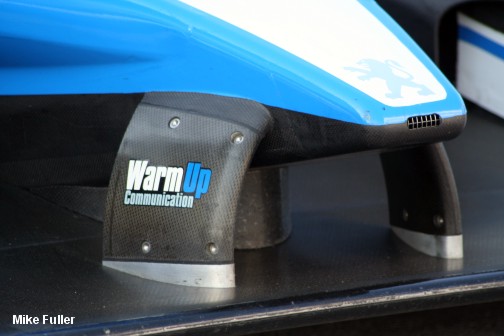 The
raised nose has become a common feature (if somewhat aesthetically
controversial)
among contemporary LMPs. Doing so frees up additional
splitter area
and improves airflow over the top of the diffuser. The small
duct
in the nose presumably helps draw cooling air into the footwell and the
mechanical components located there (power steering).
The
raised nose has become a common feature (if somewhat aesthetically
controversial)
among contemporary LMPs. Doing so frees up additional
splitter area
and improves airflow over the top of the diffuser. The small
duct
in the nose presumably helps draw cooling air into the footwell and the
mechanical components located there (power steering). 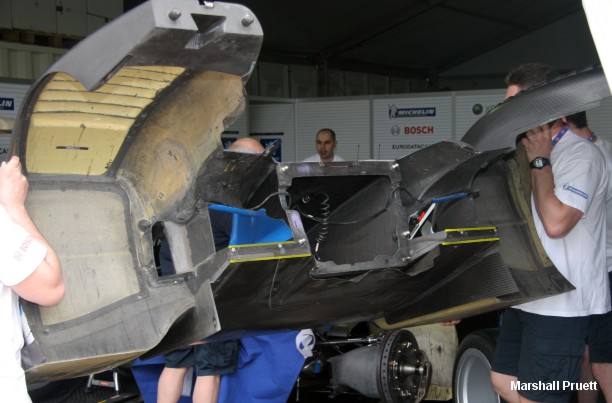 The
908's sprint/high downforce front diffuser shows a rather aggressive center section with only
two longitudinal strakes (one either side). The yellow
highlights
show the height difference between the top of the splitter and the
bottom
edge of the diffuser.
The
908's sprint/high downforce front diffuser shows a rather aggressive center section with only
two longitudinal strakes (one either side). The yellow
highlights
show the height difference between the top of the splitter and the
bottom
edge of the diffuser.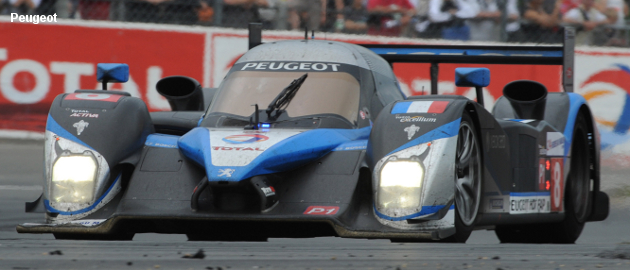 At Le Mans 2009 Peugeot introduced their low downforce nose/diffuser. The modification
amounted
to an infill panel that redirected the air over the top of the
suspension rather than through it. This was coupled with a
modified front diffuser. Interestingly enough, a similar
solution
was tested at Sebring on the Audi R10 back in 2006.
At Le Mans 2009 Peugeot introduced their low downforce nose/diffuser. The modification
amounted
to an infill panel that redirected the air over the top of the
suspension rather than through it. This was coupled with a
modified front diffuser. Interestingly enough, a similar
solution
was tested at Sebring on the Audi R10 back in 2006.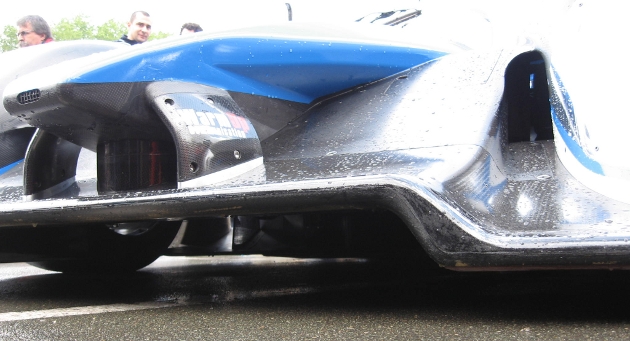 The
execution was somewhat inelegant with awkward surface transitions.
Notice how the rising bodywork intersects with the horizontal face of the lower nose
forming a
pocket. According to Peugeot's Bruno Famin, "Because the
tech rules have changed we have less
downforce and less power, the compromise difference is different
between 2008
and 2009. So we have had to deal with less downforce and less
drag meaning we
have had to adjust almost everything on the car, even if you can't
clearly see
it. (So the new front end design) is to allow us to balance
the car
aerodynamically whilst at the same time reducing drag. The drag
reduction is
necessary due to the equivalency changes and the consequent loss of
power."
The
execution was somewhat inelegant with awkward surface transitions.
Notice how the rising bodywork intersects with the horizontal face of the lower nose
forming a
pocket. According to Peugeot's Bruno Famin, "Because the
tech rules have changed we have less
downforce and less power, the compromise difference is different
between 2008
and 2009. So we have had to deal with less downforce and less
drag meaning we
have had to adjust almost everything on the car, even if you can't
clearly see
it. (So the new front end design) is to allow us to balance
the car
aerodynamically whilst at the same time reducing drag. The drag
reduction is
necessary due to the equivalency changes and the consequent loss of
power."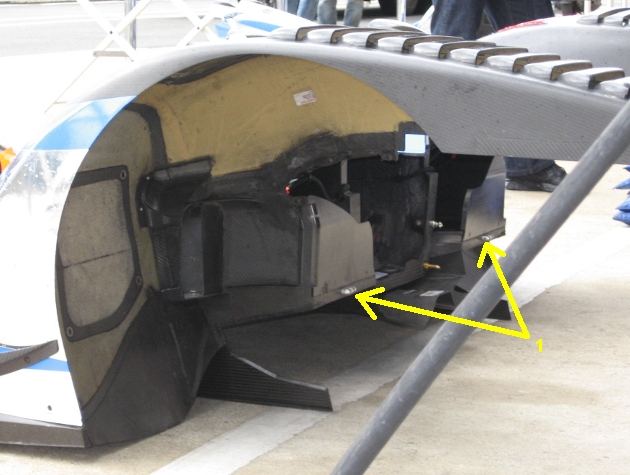 Having
a look underneath and we can see a few detailed changes such as the
elongated strakes and now the split line around the nose box/monocoque
interface now extends further rearward (compare with the sprint/high downforce splitter image above).
The diffuser's central tunnels appear slightly taller as
well.
The bodywork locaters (1) locate into the recess pointed out
in
the image below.
Having
a look underneath and we can see a few detailed changes such as the
elongated strakes and now the split line around the nose box/monocoque
interface now extends further rearward (compare with the sprint/high downforce splitter image above).
The diffuser's central tunnels appear slightly taller as
well.
The bodywork locaters (1) locate into the recess pointed out
in
the image below.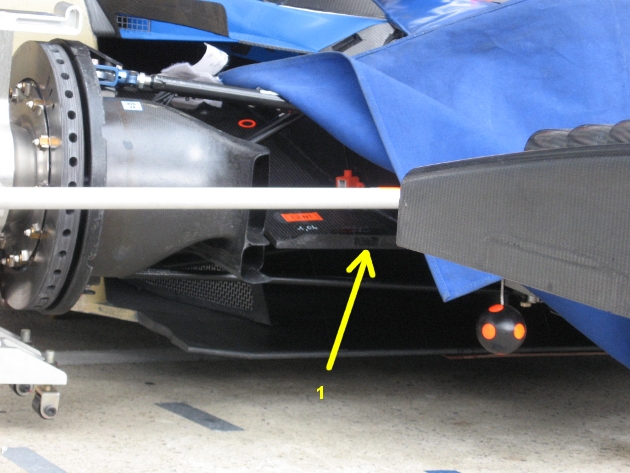 From
here we can see the front diffuser continues to rise snaking above the
lower wishbone but below the pushrod and upper wishbone. The
height of the diffuser's trailing edge is particularly high; it is
effectively to the height of the valance covers that connect the
monocoque to the fenders. The end result is of a full length
tunnel that extends from the tip of the splitter ending at the entry to
the radiators.
From
here we can see the front diffuser continues to rise snaking above the
lower wishbone but below the pushrod and upper wishbone. The
height of the diffuser's trailing edge is particularly high; it is
effectively to the height of the valance covers that connect the
monocoque to the fenders. The end result is of a full length
tunnel that extends from the tip of the splitter ending at the entry to
the radiators.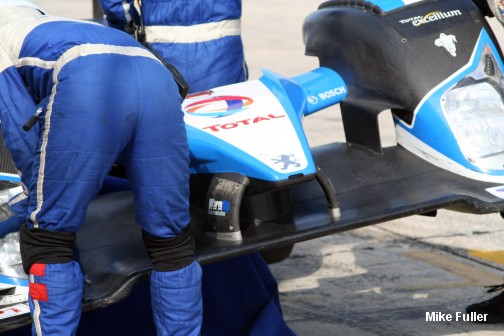 The
entire nose/diffuser quick-releases off in seconds allowing for very
rapid
replacement and access to the front suspension.
The
entire nose/diffuser quick-releases off in seconds allowing for very
rapid
replacement and access to the front suspension.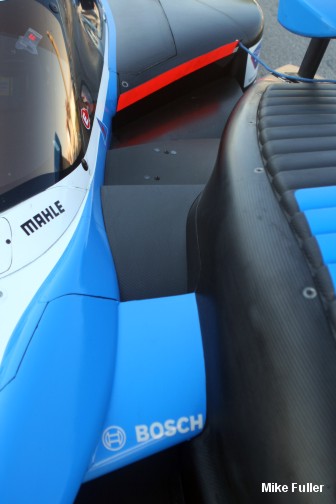 The
shutter panels are for regulations compliance and cover the suspension
and underfloor from view brining the bodywork in that area up to at
least
200 mm in height from the reference plane (the height bumps up to 400
mm
once past the cockpit opening).
The
shutter panels are for regulations compliance and cover the suspension
and underfloor from view brining the bodywork in that area up to at
least
200 mm in height from the reference plane (the height bumps up to 400
mm
once past the cockpit opening).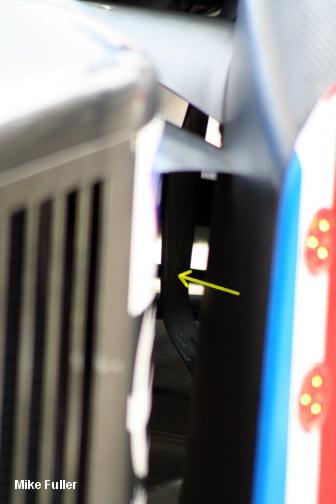 Within
the valley between the front fender and the monocoque is a turning vane
that is attached to the inner fender.
Within
the valley between the front fender and the monocoque is a turning vane
that is attached to the inner fender.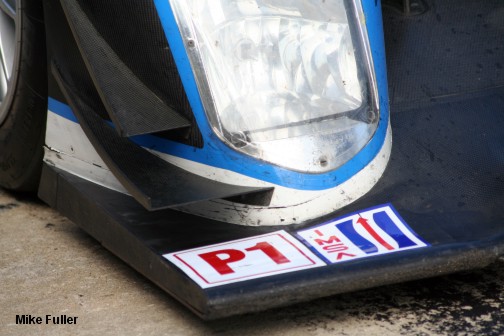 At
Sebring twin sets of dive planes with outboard gurney "endplates" were
utilized.
At
Sebring twin sets of dive planes with outboard gurney "endplates" were
utilized.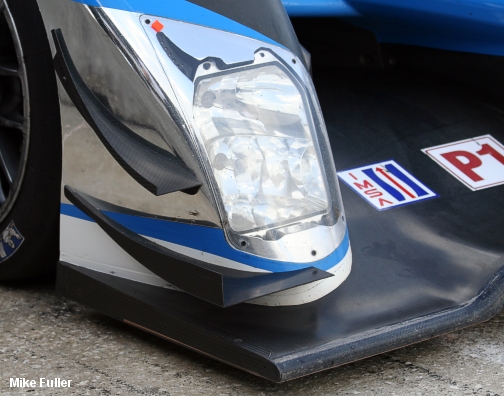 Interestingly,
a year later (and at the same track) and the lower dive plane is
larger (extends further forward) and the upper seems to have more
camber. The outer end fence is much taller on the lower diveplane
as well.
Interestingly,
a year later (and at the same track) and the lower dive plane is
larger (extends further forward) and the upper seems to have more
camber. The outer end fence is much taller on the lower diveplane
as well.With the appearance of more front balance being required, it becomes doubtful that the ACO achieved their goal of less overall downforce with the rear wing reductions.
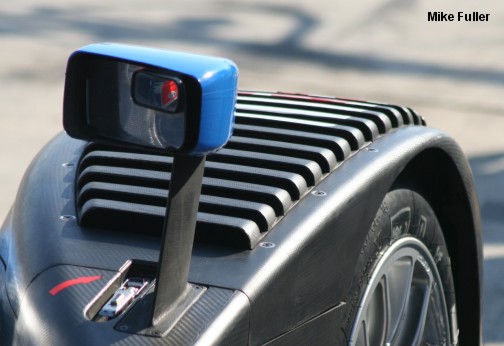 A
full set of front fender louvers also augmented the need for more front
grip in the face of higher total downforce levels being used at Sebring.
A
full set of front fender louvers also augmented the need for more front
grip in the face of higher total downforce levels being used at Sebring.